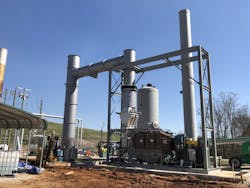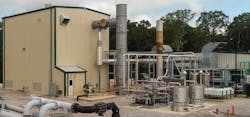About the author:
John Weigold is senior vice president of business development for Heartland Water Technology. Weigold can be reached at [email protected].
Operators of the Three Rivers Regional Landfill (“Three Rivers”) desired a simple on-site solution for managing landfill leachate. Critical elements for Three Rivers were controlling leachate management without having to rely on off-site trucking and disposal, reducing its leachate costs and creating long-term cost certainty.
Three Rivers uncovered value and flexibility by using the Heartland Hybrid CoVAP solution. Hybrid CoVAP is a configuration where exhaust heat from Three Rivers existing waste-to-energy facility (cogeneration) is combined with thermal energy from a landfill gas (LFG) flare (Hybrid) to evaporate leachate. The solution allowed Three Rivers to maximize the value of its landfill gas and realize the lowest life-cycle cost for its leachate management.
Challenge
Three Rivers, like many landfills, had a long-standing relationship with its local publicly owned treatment works (POTW), which had been accepting 12,000 to 24,000 gallons per day (gpd) of its landfill leachate for many years.
Unfortunately, transport and disposal (T&D) costs were consistently rising and Three Rivers was paying more than $0.09 per gallon for off-site leachate disposal. Adding to Three Rivers concerns was talk that the local POTW may discontinue accepting leachate and the T&D cost for the next closest disposal outlet would be greater than $0.20 per gallon.
Faced with rising costs and the threat of a steep change that could double or triple its costs without warning, Three Rivers took proactive steps.
“Controlling our own destiny — both in terms of our technology road map and our long-term operating costs — is an important goal for Three Rivers,” said Jon McDonald, operations manager for Three Rivers. “The Hybrid CoVAP configuration of the Heartland concentrator has enabled us to do just that.”
Three Rivers conducted a comprehensive RFP looking at on-site leachate management options. Three Rivers was clear on its requirements with the following parameters:
- Find a trusted vendor with a proven solution on-site leachate treatment.
- Select a partner to completely design and install the solution.
- Find a solution that would not rob LFG from the waste-to-energy facility.
- Select a simple-to-operate solution.
- Abide by the facility’s Title V Air permit requirements.
- Meet an expectation of a 20-year product life.
After extensive analysis, Three Rivers selected the lowest total life-cycle cost option that met its requirements, which was the Heartland Concentrator in a 25,000 gpd Hybrid CoVAP configuration.
RELATED: Locking Up Leachate
Hybrid CoVAP Configuration
CoVAP stands for Cogeneration for Industrial Evaporation. The concentrator was designed and patented for using waste heat from engines or turbines beneficially to evaporate wastewater. This is a classic cogeneration solution, and the configuration Three Rivers selected combined cogeneration with additional heat from a landfill gas flare. This configuration is particularly valuable when one wants to use the thermal energy from cogeneration beneficially but there is insufficient heat to evaporate all the leachate.
This solution provided economic benefit to Three Rivers by allowing it to run at full capacity while using less LFG. This capability maximized the value of LFG by always running the energy plant and never compromising between generating renewable energy and evaporating leachate.
The flare design provides sufficient thermal energy to run the evaporation plant at capacity, if required, without the need for the exhaust from the energy plant should the energy plant be down for any reason. A simple and easy-to-configure control system automatically balances thermal demand between the flare and the engine waste heat.
Cogeneration
The concentrator is designed to evaporate 25,000 gallons per day. Thermal energy from the exhaust of the on-site 2G supplied 999kW Caterpillar-MWM Landfill Gas engine is sufficient to evaporate 5,000 gallons of leachate per day. The balance of the required heat for evaporation is provided by the landfill gas flare.
Figure 1 shows the integration between flare and on-site engine. This simple integration drafts the waste heat from the engine exhaust stack. Consequently, there is no back pressure placed on the engine, making this a safe integration.
Performance Optimization
The Three Rivers Operating Team are experienced operators. In a joint development effort, Heartland and the Three Rivers team collaborated on many aspects of performance optimization, including additional automation to improve productivity and enhanced clean-in-place to extend routine maintenance cycle-times. The teams continue to collaborate long past commissioning and strive to uncover new understanding and methods in the never-ending journey of continuous improvement.
As of September 2020, Three Rivers had treated an average of more than 23,000 gpd of landfill leachate achieving volume reduction of greater than 96% and more than 90% up-time.
Conclusion
Prior to installing the concentrator, Three Rivers was spending a minimum of $0.095 per gallon in transportation and disposal costs and faced the possibility of costs increasing to levels above $0.20 per gallon. With the new equipment installed, Three Rivers estimates total cost, including operating costs and capital recovery, to be $0.06 per gallon. The system is in place for the long-term providing cost-certainty and giving Three Rivers the full control of its leachate treatment.

